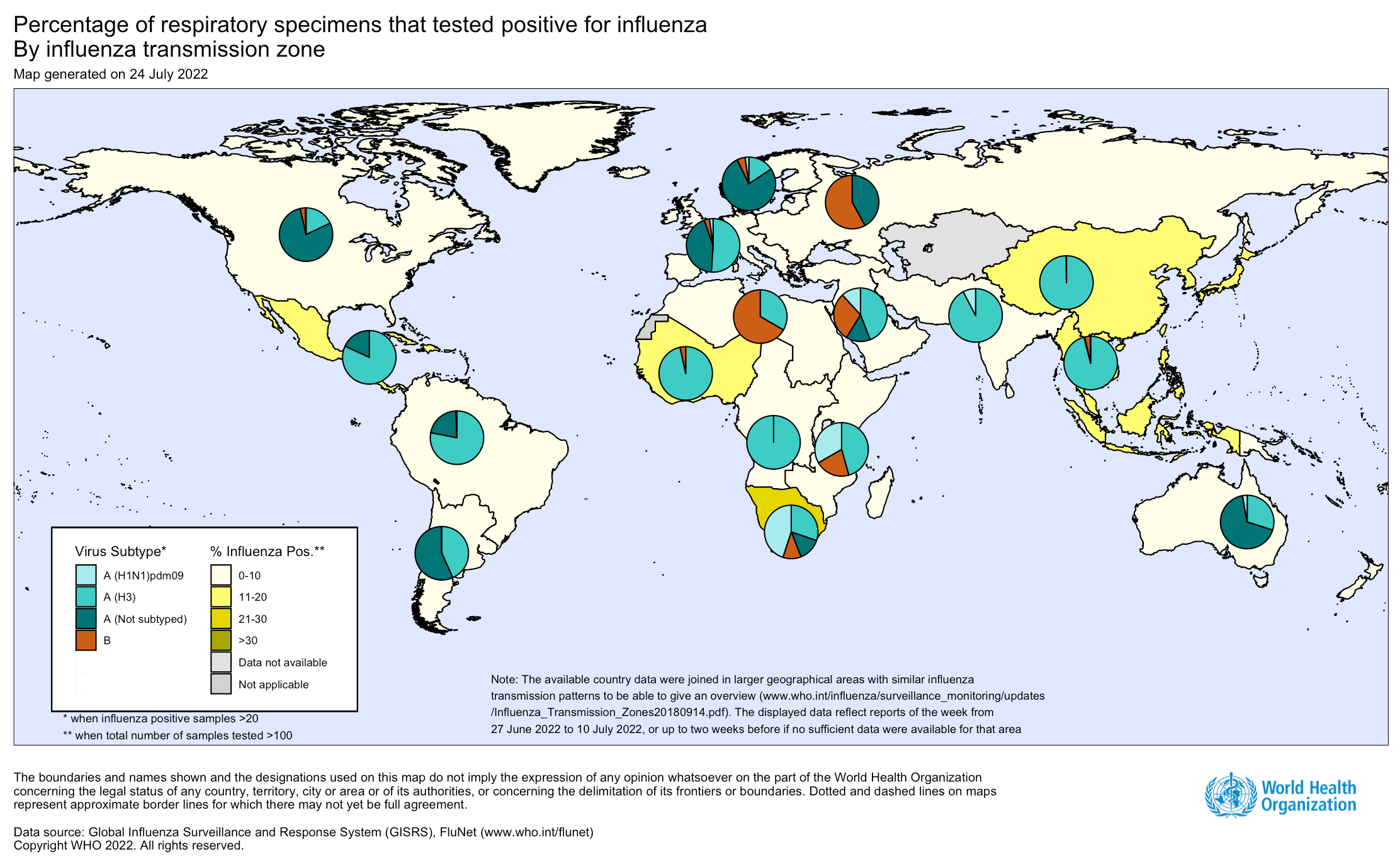Influenza Update N° 424

Overview
25 July 2022, based on data up to 10 July 2022
Information in this report is categorized by influenza transmission zones, which are geographical groups of countries, areas or territories with similar influenza transmission patterns. For more information on influenza transmission zones, see the link below:
Influenza Transmission Zones (pdf, 659kb)
- The current influenza surveillance data should be interpreted with caution as the ongoing COVID-19 pandemic has influenced to varying extents health seeking behaviours, staffing/routines in sentinel sites, as well as testing priorities and capacities in Member States. Various hygiene and physical distancing measures implemented by Member States to reduce SARS-CoV-2 virus transmission have likely played a role in reducing influenza virus transmission.
- Countries are recommended to monitor the co-circulation of influenza and SARS-CoV-2 viruses. They are encouraged to enhance integrated surveillance and step-up their influenza vaccination campaign to prevent severe disease and hospitalizations associated with influenza. Clinicians should consider influenza in differential diagnosis, especially for high-risk groups for influenza, and test and treat according to national guidance.
- Global influenza activity has steadily decreased from a peak in March 2022.
- In the temperate zones of the southern hemisphere, overall influenza activity appeared to decrease slightly this reporting period.
- In Oceania, influenza detections appeared to have peaked in some regions of Australia and in New Zealand, with continued detections of predominantly influenza A(H3N2) viruses.
- In Southern Africa, influenza activity decreased slightly overall with continued detections of influenza A(H1N1)pdm09 and influenza A(H3N2) and a few influenza B viruses.
- In temperate South America, influenza activity decreased overall. Influenza A(H3N2) viruses predominated among subtyped detections.
- In the Caribbean and Central American countries, low influenza activity was reported with influenza A(H3N2) predominant.
- In the tropical countries of South America, influenza detections were low, and A(H3N2) detections predominated.
- In tropical Africa, influenza activity continued to decrease. Influenza A viruses predominated among the reported detections.
- In Southern Asia, influenza detections of predominantly A(H3N2) increased in some reporting countries but remained at low levels overall.
- In South-East Asia, influenza virus detections increased. Influenza A(H3N2) predominated.
- In the countries of North America, influenza activity continued to decrease to levels typically observed at this time of year. Activity was predominantly due to influenza A viruses, with A(H3N2) predominant among the subtyped viruses.
- In Europe, overall influenza activity remained at low inter-seasonal levels with influenza A(H3N2) predominant among the subtyped viruses.
- In Central Asia, no influenza detections were reported.
- In Northern Africa, no influenza detections were reported.
- In East Asia, influenza activity of predominantly influenza A(H3N2) continued to increase and influenza-like illness (ILI) activity decreased this reporting period in the southern provinces of China. Elsewhere, influenza illness indicators and activity remained low.
- In Western Asia, low numbers of detections of influenza A(H1N1)pdm09, A(H3N2) and B viruses were reported.
- National Influenza Centres (NICs) and other national influenza laboratories from 102 countries, areas or territories reported data to FluNet for the time period from 27 June 2022 to 10 July 2022* (data as of 25/7/2022 3:46:21 AM UTC). The WHO GISRS laboratories tested more than 89 819 specimens during that time period. 4386 were positive for influenza viruses, of which 4323 (98.56%) were typed as influenza A and 63 (1.44%) as influenza B. Of the subtyped influenza A viruses, 95 (2.19%) were influenza A(H1N1)pdm09 and 2587 (59.84%) were influenza A(H3N2). Of the characterized B viruses, 19 (100.00%) belonged to the B/Victoria lineage.

- COVID-19 positivity from sentinel surveillance increased over the reporting period to over 50%. Increases were observed in all regions of WHO, except in the African Region of WHO. Activity from non-sentinel sites continued to increase, with overall positivity around 50%.
- National Influenza Centres (NICs) and other national influenza laboratories from 69 countries, areas or territories from six WHO regions (African Region: 8; Region of the Americas: 21; Eastern Mediterranean Region: 4; European Region: 27; South-East Asia Region: 6; Western Pacific Region: 3) reported SARS-CoV-2 testing data from sentinel surveillance sites to FluNet for the time period from 27 June 2022 to 10 July 2022* (data as of 25/7/2022 13:32:50 PM UTC). The WHO GISRS laboratories tested more than 58 154 sentinel specimens during that time period and 31 695 (54.50%) were positive for SARS-CoV-2. Additionally, more than 413 899 non-sentinel or undefined reporting source samples were tested in the same period and 197 956 were positive for SARS-CoV-2. Further details are included at the end of this update.
Source of data
______________________________________________________________________________________________
The Global Influenza Programme monitors influenza activity worldwide and publishes an update every two weeks. The updates are based on available epidemiological and virological data sources, including FluNet (reported by the WHO Global Influenza Surveillance and Response System), FluID (epidemiological data reported by national focal points) and influenza reports from WHO Regional Offices and Member States. Completeness can vary among updates due to availability and quality of data available at the time when the update is developed.
*It includes data only from countries reporting on positive and negative influenza specimens.
